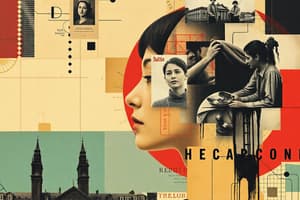Podcast
Questions and Answers
Which type of motion is characterized by an object moving in response to an external force?
Which type of motion is characterized by an object moving in response to an external force?
- Dynamic Motion
- Organic Motion
- Mechanical Motion (correct)
- Kinetic Motion
Which form of motion is driven by the internal dynamics of living organisms?
Which form of motion is driven by the internal dynamics of living organisms?
- Mechanical Motion
- Organic Motion (correct)
- Biological Motion
- Dynamic Motion
In New Critical Realism, which type of motion is considered a constructive force shaping the world?
In New Critical Realism, which type of motion is considered a constructive force shaping the world?
- Mechanical Motion
- Organic Motion
- Energetic Motion
- Dynamic Motion (correct)
Which type of motion encompasses velocity, acceleration, and other dynamic variables over time?
Which type of motion encompasses velocity, acceleration, and other dynamic variables over time?
What does social motion in New Critical Realism refer to?
What does social motion in New Critical Realism refer to?
What is psychic motion according to the text?
What is psychic motion according to the text?
How is relative motion defined in New Critical Realism?
How is relative motion defined in New Critical Realism?
In New Critical Realism, what does temporal motion refer to?
In New Critical Realism, what does temporal motion refer to?
Which type of motion is driven by political, economic, and cultural factors?
Which type of motion is driven by political, economic, and cultural factors?
How does psychic motion interact with other forms of motion?
How does psychic motion interact with other forms of motion?
Flashcards are hidden until you start studying
Study Notes
Exploring Types of Motion in New Critical Realism Textbooks: A Guide to Time and Motion
If you're diving into the fascinating world of New Critical Realism, you'll discover a nuanced approach to understanding the concepts of time and motion that goes far beyond the basic principles of physics. As you engage with the thought-provoking ideas presented in these texts, you'll encounter the following subtopics, which reveal the rich tapestry of motion and its relationship with time.
1. Mechanical Motion
This is the most familiar form of motion, where an object moves in response to an external force. Mechanical motion is quantifiable, predictable, and governed by Newton's laws of motion. In New Critical Realism, mechanical motion serves as a foundation for a deeper exploration of motion's more complex forms.
2. Dynamic Motion
Dynamic motion refers to the continuous change of an object's motion over time. It encompasses velocity, acceleration, and other dynamic variables, but in the context of New Critical Realism, dynamic motion is also seen as a constructive force that shapes the world in which we live.
3. Organic Motion
Organic motion is the type of motion that arises from the internal dynamics of living organisms. This form of motion is driven by the organism's inherent biological processes, such as muscle contractions, growth, and development. Organic motion is a fascinating area of study for New Critical Realism, which emphasizes the interplay between the natural world and the human world.
4. Social Motion
In the context of New Critical Realism, social motion refers to the collective behavior of social groups. This form of motion is characterized by patterns of interaction, cooperation, and conflict among individuals. Social motion is driven by political, economic, and cultural factors, and it plays a central role in shaping the course of history.
5. Psychic Motion
Psychic motion is the type of motion that arises from the internal dynamics of human consciousness. This form of motion is seen as a constructive force that shapes our individual and collective experiences. Psychic motion interacts with other forms of motion, such as mechanical, dynamic, organic, and social motion, to create a rich tapestry of human experience.
6. Relative Motion
Relative motion is the motion of one object relative to another. This form of motion is fundamental to our understanding of the universe, as it reveals the interconnectedness of all things. In New Critical Realism, relative motion is seen as a constructive force that shapes our understanding of time and space.
7. Temporal Motion
Temporal motion refers to the motion of time itself. In New Critical Realism, temporal motion is seen as a constructive force that shapes our understanding of the universe. Temporal motion interacts with other forms of motion, such as mechanical, dynamic, organic, social, and psychic motion, to create a rich tapestry of human experience.
As you delve into these complex subtopics and their multifaceted interactions, you'll begin to see how New Critical Realism offers a fresh perspective on the role of motion and time in shaping the world around us. You'll learn how these forms of motion interact, shape, and are shaped by one another, ultimately leading you to a deeper understanding of the human experience and the world in which we live.
Studying That Suits You
Use AI to generate personalized quizzes and flashcards to suit your learning preferences.





